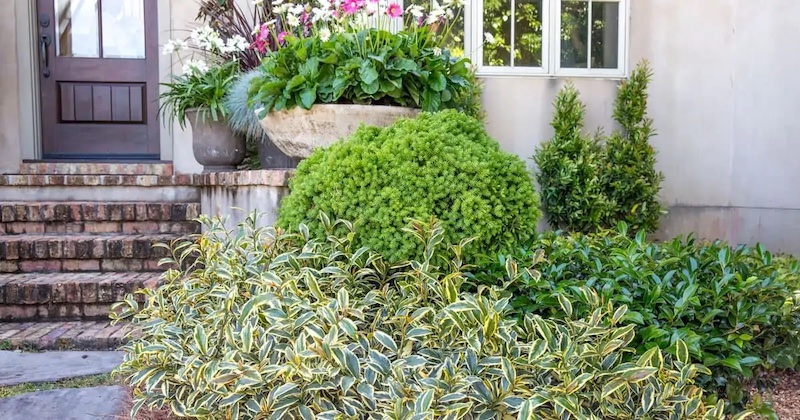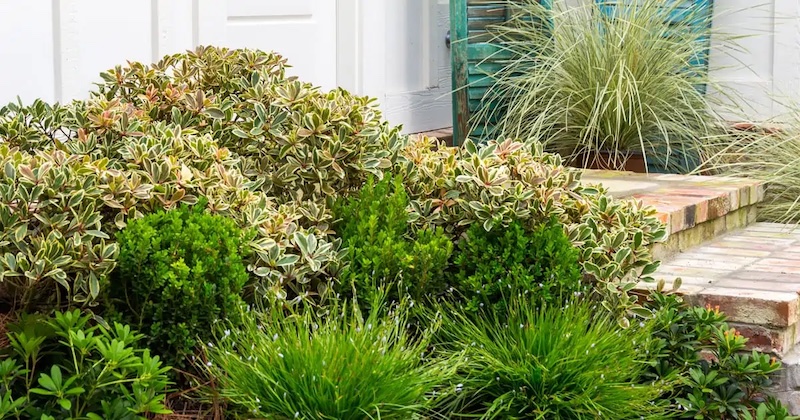Cleyera are the ultimate low-maintenance, trouble-free shrubs for a foundation planting, mixed shrub border, or low-growing clipped hedge. Their broadleaf evergreen foliage is resistant to most pests and diseases and provides interest in the garden for four seasons of the year. Pair cleyera with plants featuring contrasting leaf colors and textures for a beautiful effect to enhance or improve your house's curb appeal.
Even though Cleyeras are tolerant of full sun, they grow better in partially shaded locations with protection from afternoon sun. Cleyera can be pruned into topiary or left to grow into its natural mounded shape for lower maintenance and an informal feel. Any soil is suitable for Cleyera as long as it is well draining with moderate levels of nutrients.

Shrubs To Plant With Cleyera
Evergreen shrubs are natural partners for Cleyeras when you want to plant an impressive but low-maintenance design. Some standout evergreens include hinoki cypress, euonymus, loropetalum, compact holly, and leucothoe, which all have fantastic foliage colors and shapes to make an interesting foundation planting or island bed in a large driveway. Blooming shrubs are another way to go with Cleyera. Use the unfading foliage colors of Cleyera to set off the flowers of azaleas, gardenias, crepe myrtle, fothergilla, witch hazel, or red twig dogwood.
Perennials To Plant With Cleyera
The brightly colored foliage of Cleyera looks good against perennials with a strong architectural shape. Select from agapanthus, blue-eyed grass, and ornamental grasses, which stand out against formal clipped hedges or informal mounded shapes. Plant seasonal bulbs like daffodils, tulips, snowdrops, alliums, canna, or calla lilies at the base of Cleyera for shots of color that progress through the growing season.
These plant combinations will require excellent drainage, even during the winter months. An annual fertilizing with a granular slow-release formulation will keep all plants blooming well and growing vigorously. A fertilizer with a balanced NPK ratio of 1-1-1 or 5-5-5 will support healthy growth for both foliage plants and blooming plants.

Annuals To Plant With Cleyera
Heat-loving annuals are great for adding color to evergreen plantings with Cleyera. Depending on the look you desire, annuals in hot colors or calming cool colors (including all white) can be mixed and matched with Cleyera. Some of our favorite companions include African daisies, wax begonia, celosia, and French marigold because they flower non-stop until the first frost and come in a wide range of hot and fiery colors. For a ground cover, consider planting sweet potato vine, mandevilla, and dipladenia, featuring varied leaf shapes and bright color. For a relaxed feel, combine cleyera with pentas, cleome, caladium, and angel wing begonia in calming colors and plant in rich, moist soil.
Best Companion Plants For Cleyera in Containers
Cleyera grows well in pots either alone or as part of a planned seasonal planter. Use it as a thriller element in a grouping that includes plenty of long-blooming plants to complement Cleyera’s bright foliage. Some of our favorite pot mates include verbena, calibrachoa, supertunias and sweet potato vine.
Potted Cleyeras need plenty of room for their root system to develop. You will need to repot this shrub every 2-3 years to refresh the potting mix and size up the pot. Apply a granular slow-release fertilizer in the spring as a top dressing. This will work its way into the soil every time the pot is watered and support healthy growth all season. An all-purpose formulation with a balanced NPK ratio works perfectly for this.
Plants Not To Grow With
Cleyera requires consistently moist soil that drains well. Plants that grow alongside streams and in ponds, such as cattails, gunnera, willows, and papyrus reeds, require much more moisture than Cleyera. Plants that prefer dense shade, such as ferns, hostas, toad lilies, forest grass, and hellebore, also do not make good companions for Cleyera. These plants can grow in part shade, but will not look their best growing in locations with more than 4-6 hours of sun a day.
Best Plants To Grow With Cleyera
The best use of Cleyera is in a foundation planting or a mixed evergreen hedge where its brightly colored foliage can be on display year-round. It can be left to assume its natural mounded shape or clipped into a simple topiary. In either form, Cleyera will dress up a porch or patio when planted alongside cryptomeria and perennials with a striking presence such as agapanthus and African daisies.
 |
Author Robbin Small - Published 10-20-2023 |
